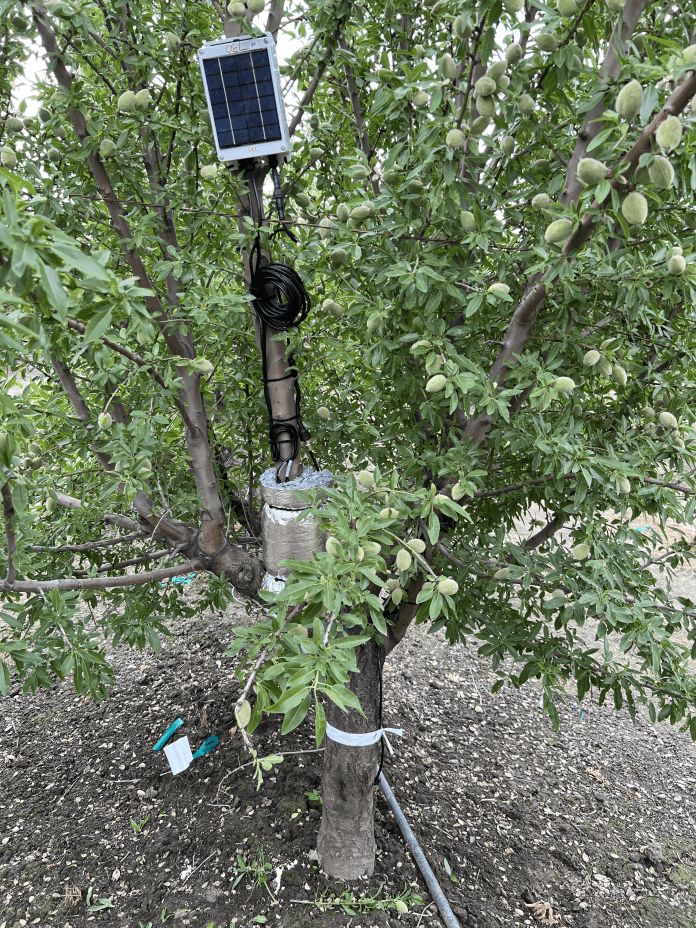
Sensors installed in tree trunks or scaffold branches measure plant moisture status automatically, enabling users to fine-tune their irrigation while reducing the need to take time-consuming pressure bomb readings.
At least three manufacturers market tree sensors: Davis-based FloraPulse, Rancho Cordova-based Saturas USA and Tulare-based Phytech US. Each uses a different technology to reach the same goal: automating the labor-intensive practice of measuring tree water stress.
FloraPulse uses microtensiometers to provide stem water potential readings every 20 minutes. Saturas uses osometers to measure stem water potential (SWP) and provides a daily report. Phytech uses dendrometers to measure trunk expansion and contraction. This is translated into a tree stress index ranging from 0 to 100 (what it calls MDS or Maximum Daily Shrinkage.)
Although the technology isn’t cheap, proponents say it may pay for itself with potential water savings, labor savings, yield and quality improvements, and healthier trees.
“We have seen growers who have definitely saved water,” said Michael Santiago, CEO and a founder of FloraPulse. “One of our growers was able to reduce water use by almost 50%, but that may not be typical. If they’re doing pressure bombing, they can save on that. And depending on the soil, people may not be irrigating frequently enough. It’s hard to describe the individual benefits, but it definitely helps them irrigate better.”
Ziv Atia, head of agronomy for Phytech, agreed and said that as with every new technology, grower adoption is gradual. Phytech has onsite teams that help growers through the implementation process by pinpointing real time opportunities to increase return on investment and improve grower success.
“The benefits of using the Phytech system is grower specific and depends on predetermined goals set in the beginning of the season like increase in yield quality and quantity, decrease in amounts of water applied and energy consumption, and improved water/fertilizer use efficiency and increased operational visibility,” he said.
Nut growers traditionally rely on ETc calculations, historic irrigation data or soil moisture measurements to determine specific parameters such as filled capacity, permanent wilting point and maximum allowable depletion in order to get a recommend amount of applied water. But Phytech uses multiple sensors, which monitor the plant’s real-time physiological state based on MDS and growth rates to determine best irrigation practices. Atia said growers therefore get a more complete picture for planning irrigation schedules and evaluating the effectiveness of a certain irrigation protocol.
Atia said Phytech’s plant status calculations provide a continual measurement of stress and installing one dendrometer a tree trunk per plot enables daily granular plot monitoring in complete ranches, which would require a “small army” using traditional manual pressure chambers.
Phytech currently services about 167,000 acres of almonds, pistachios and walnuts in California and acreage continues to grow, Atia said.
Sensors as a Complement to Pressure Bombs
Ryan Kaplan of Pressure Bomb Express, also a FloraPulse dealer in Northern California, said he had more than 50 units in mostly almond growers’ orchards last year, and he would have had more were it not for supply chain issues that limited availability of some of the components. Kaplan said he sees increasing interest in the technology because of its labor savings, frequent SWP readings and water savings potential.
“I haven’t done sales yet this year, but I do know that all of the growers who used it last season want to continue,” he said. “With commodity prices being down and input costs up, I’m not sure how many growers are going to want to spend on new technology. But this is technology that could significantly increase their bottom line as well as overall orchard health.”
As with any new technology, Kaplan said the FloraPulse sensors are not 100%, but they’re “super promising” and issues are infrequent. He recommended pairing them with midday SWP readings from pressure bombs, long considered the gold standard, at least until users understand how readings from the two technologies correlate.
“It’s not going to be perfect, but it’s going to be pretty close,” said Kaplan, a second-generation grower who uses FloraPulse sensors in his own prune and pistachio orchards near Orland. “If you have pressure bomb readings, you can compare them. If it’s consistently off by the same amount, then we can calibrate [the sensor]. At this point, I think growers need to own a pressure bomb and take readings on the sensor tree or you can work with a company to take a couple of comparison readings on the tree.”
FloraPulse, founded by three Cornell University researchers, offers the technology through an annual subscription and recommends one unit per irrigation block. Within nut crops, the sensors have performed well in almonds and pistachios, but Santiago said they’re still having some challenges with walnuts and pecans.
During sensor installation, a small wound is made in the tree trunk or scaffold. Walnuts and pecans have a strong wound response, which overwhelms the sensor and prevents it from accurately reading water status within the xylem.
“We’re working on ways around that and we’ve had some success, but things like this take time,” he said. “We’re developing a new installation method with Dr. Shackel.”
Although soil moisture sensors can provide information about the amount of moisture in the soil, they don’t reflect how much of that is actually being taken up by the tree. Stem water potential gives a reading of what’s occurring within the xylem (tissue that transports water from plant roots to stems and leaves.)
Water in the xylem is always under some degree of tension. As evapotranspiration increases, the roots can’t keep pace and the tension increases. Reported as a negative value or as negative bars, the tension is an indication of a water deficit or water stress.
During the middle of the day when temperatures near their peak and photosynthesis is greatest, the tree is most actively pulling moisture through the xylem into the leaves. This timing typically coincides with the tree’s greatest water stress and recommended midday SWP pressure bomb or pressure chamber readings.
In a two-year almond trial at the Kearney Agricultural Research and Extension Center near Parlier, Calif., Ken Shackel, UC Davis professor of plant science and pomology, compared pressure bomb midday SWP readings to those from the three sensors. Overall, he found seasonal stress patterns were similar with all sensors with varying levels of correlation to traditional pressure bomb readings.
Installing Sensors
Ideally, Kaplan said FloraPulse sensors should be installed during cold mornings shortly after leaf-out. The process begins with selecting a healthy tree that’s representative of the block. Placing the sensor in a 2-inch scaffold branch or high on the main trunk helps avoid possible shaker damage.
Installation is relatively straight forward and takes 40 to 45 minutes. But Kaplan said some grower-customers are initially hesitant about doing it themselves, so he shows them how to do it so they can do so in the future if they choose.
Users hammer a metal sleeve about the diameter of the pinky finger into the tree until it hits the hardwood core. After drilling out the debris in the sleeve, users fill it with a special “mating” or bonding compound before pushing the sensor into the sleeve. They cap the sensor and apply grease around the sleeve hole. To provide redundancy, a second sensor is installed nearby but at least 3 inches diagonally or to the side. The sensors are then wrapped with reflective insulation, which is zip-tied in place. A pressure switch also is connected to the drip irrigation hose so users can see whether water is running.
Then users hang the datalogger and telemetry unit, a roughly 4-by-8-inch box, in a tree crotch where it won’t be easily dislodged and zip-tie it and the wires leading from the sensors in place.
The datalogger, powered by a small solar panel, searches for the best cell signal to use to send data. At times, finding a cell signal can be a challenge, and Kaplan said there are some orchards where data transmission isn’t feasible.
Currently, FloraPulse sensors maintain accuracy for one season and new ones have to be installed before the beginning of the following season. Santiago said it may be that the tree is trying to wall off the wound as a defense mechanism. But making sensors that last more than a season is one of their many goals.
For the Phytech system, dendrometers are installed above the graft line using a single screw year-round, however, ideally for mature bearing trees, Atia recommends installation at the beginning of the season prior to leaf out and bloom to allow tree monitoring throughout all the different phenological stages.
“By doing so we promote growth and decrease stress level during key phenological stages, and increase water/nutrient use efficiency, hence, the grower’s chances to meet the orchard yield potential,“ Atia said.
In young nonbearing trees he recommends monitoring when trunk diameter is around 1 inch. Preventing stress and promoting maximum growth rates in young trees will allow faster orchard establishment and decrease time until the orchard will reach full production potential. The dendrometers are part of a full suite of Phytech farm management technology.
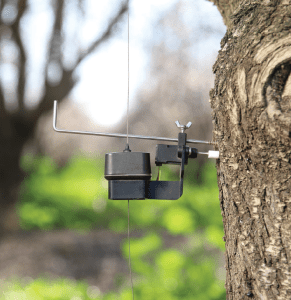
Using the Data
Environmental conditions, such as temperature and relative humidity, affect what normal or “baseline” pressure bomb midday SWP values should be in a fully irrigated orchard. This also should hold true for FloraPulse sensor midday readings, since they generally are similar to those of pressure bombs.
University of California has tables for download at bit.ly/3b1C9KF that calculate baselines based on temperature and humidity. A website is also available (informatics.plantsciences.ucdavis.edu/Brooke_Jacobs/index.php) that provides these values for the last six days for any of the CIMIS weather station locations.
The tree growth stage during the season also influences the amount of stress desired. In almonds, for example, moderate stress shortly before hull split reduces hull rot and stick-tights and promotes more even nut removal.
By comparing baseline values to actual midday SWP measurements in their orchard, users can determine whether irrigation is needed.
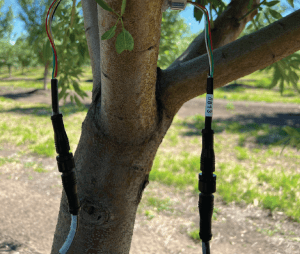
To streamline those calculations, Kaplan developed the Pressure Bomb Express app, which runs on a smartphone or tablet. Although initially designed for use with pressure bombs, he said the latest versions also accept data downloaded automatically from FloraPulse sensors.
“Because we’re measuring the same thing with the manual pressure bomb and the sensors, we can download the data into the app and review it and display it the same as manual samples,” he said.
Drawing from years of UC pressure chamber research, the app builds a report showing the level of tree stress and recommendations with the baseline and crop-specific seasonal growth stages already factored in. It also allows users to compare manual pressure bomb readings to those of the FloraPulse sensors all on one screen.
Pressure Bomb Express for manual pressure bomb use is available through a subscription, which includes updates and training. When FloraPulse sensors are purchased through Pressure Bomb Express, growers also gain access to their sensor data on the Pressure Bomb Express app at no additional cost.
Phytech uses an IoT platform, and all sensors are wireless. Data from each individual sensor is sent to central data loggers that distributed evenly throughout the plots. Data loggers transmit the data to via cellular network to a cloud-based server where further analysis is done. Phytech uses crop / verity specific algorithms to determine the plant status (a plant health index based on water availability) and deliver an intuitive color-coded indicator of that PS through am app or web site. A dedicated team of will follow up through the entire season to help increase embedding the technology for optimum results.
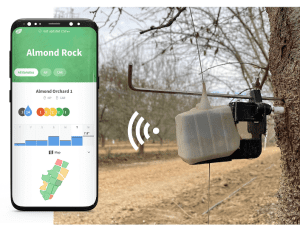
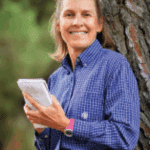
Vicky Boyd | Contributing Writer
A veteran agricultural journalist, Vicky Boyd has covered the industry in California, Florida, Texas, Colorado, the South and the Mid-South. Along the way, she has won several writing awards. Boyd attended Colorado State University, where she earned a technical journalism degree with minors in agriculture and natural resources. Boyd is known for taking complex technical or scientific material and translating it so readers can use it on their farms. Her favorite topics are entomology, weeds and new technology. When she’s not out “playing in the dirt,” as she calls agricultural reporting, Boyd enjoys running, hiking, knitting and sewing.















